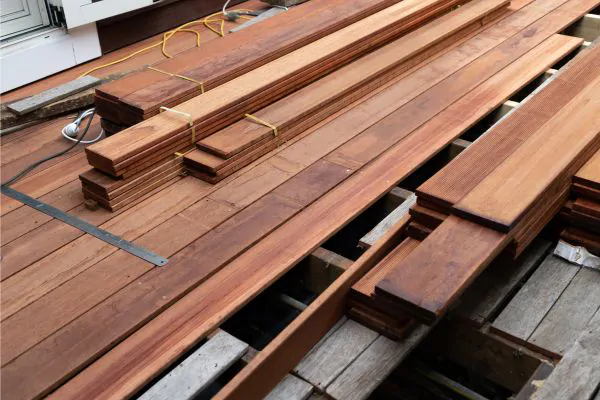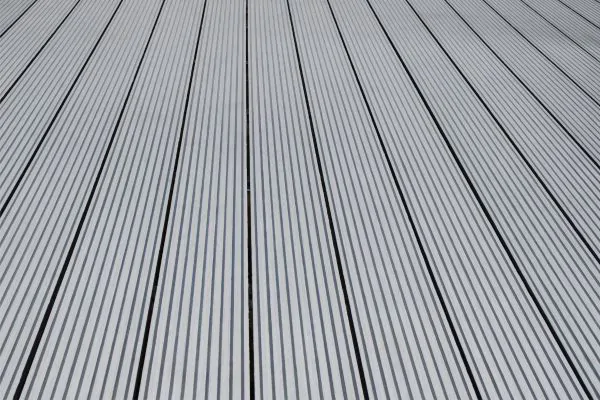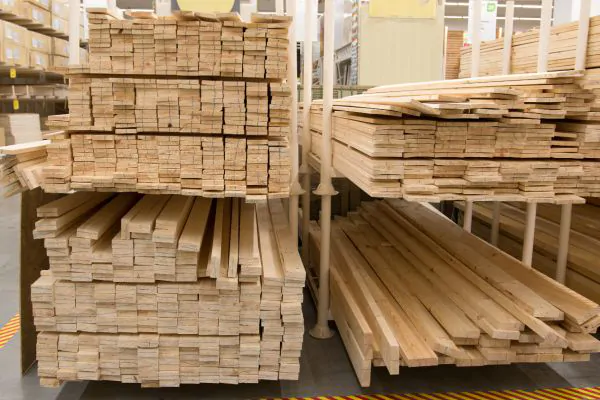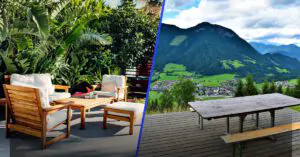Selecting the perfect deck building materials for your home is a decision that blends functionality with aesthetics, incurring a significant impact on both the usability and the visual appeal of your outdoor area.
From traditional wood decks to innovative composite options, the sheer variety available today can make this choice both exciting and somewhat daunting.
It’s essential to weigh factors such as durability, maintenance, and environmental impact to ensure your deck stands the test of time and aligns with your values.
Keep reading this blog to navigate the sea of options and pinpoint the deck building materials that will best suit your lifestyle and home.
I. Understanding Your Priorities
Deck construction entails a thorough assessment of priorities, laying a foundation for critical decisions ahead.
A clear understanding of the intended function of the guides is the selection of deck materials, ensuring they cater to activities ranging from tranquil mornings sipping coffee to bustling evenings hosting gatherings.
Equally paramount is the establishment of a budget, which acts as a boundary within which choices are made, influencing not only the extent of customization but also the quality of deck materials accessible.

Finally, considerations of maintenance shape the long-term relationship homeowners will have with their deck, dictating the amount of time and resources they are prepared to invest in its upkeep.
These foundational decisions pave the way for a tailored approach to selecting deck building materials, ensuring the final structure aligns seamlessly with homeowners’ lifestyles and preferences.
1. Defining Your Purpose
Defining the purpose of your deck is a pivotal first step in the planning process, as it directly influences the selection of suitable deck materials. Whether the vision is for a serene retreat for morning meditation or a robust platform capable of supporting lively social gatherings, each anticipated use dictates distinct requirements for durability, aesthetics, and functionality. This initial clarity ensures that every choice made thereafter, from the types of deck building materials to specific design features, aligns perfectly with the intended use, enhancing both satisfaction and utility.
2. Setting Your Budget
Setting a budget emerges as a crucial step that significantly influences the selection of deck building materials. It establishes a financial framework, guiding homeowners through an array of options from premium composite decks to more traditional, yet cost-effective wood decks. The established budget acts as a compass, navigating through choices that balance between desire for durability, aesthetics, and the economic feasibility of the project, ensuring the final selection harmonizes with both financial constraints and project ambitions.
3. Considering Maintenance Preferences
Maintenance preferences play a significant role in selecting deck building materials, as they directly impact the homeowner’s future interaction with the deck. Homeowners who prefer a low-maintenance solution often gravitate towards composite or PVC decks, known for resisting weathering, stains, and fading without the need for regular maintenance. On the other hand, individuals willing to invest more time into upkeep might opt for traditional wood decking, which requires periodic maintenance but offers the warm, natural aesthetic that only real wood can provide.
Related Post: How Much Does It Cost To Install A Deck?
II. Traditional Wood Decking Options
Navigating through deck building materials unveils the timeless appeal of traditional wood decking, a choice celebrated for its natural beauty and warmth.
This section delves into the allure of wood as a foundational substance for decks, laying bare the characteristics that make it an enduringly popular deck material.
As we explore the variety of wood options available for decking, distinguishing between them based on durability, cost, and visual appeal becomes essential.
This journey through the world of wood decking will also address the balance of advantages and challenges inherent in selecting wood, offering a comprehensive view of what homeowners can expect in terms of aesthetics, maintenance, and longevity.

By providing a clear overview of traditional wood, examining the diverse types available, and weighing the benefits against the potential drawbacks, this section aims to equip homeowners with the knowledge needed to make an informed decision when leaning towards the charm and authenticity of a wood deck.
1. Traditional Wood Characteristics and aesthetic appeal
The allure of traditional wood in deck construction emanates from its inherent warmth and natural beauty, characteristics that have preserved its status as a beloved decking material through generations. Wood decks effortlessly blend with outdoor environments, offering a spectrum of colors and textures drawn directly from nature. This organic aesthetic appeal, coupled with the tactile experience of real wood underfoot, creates an inviting outdoor living area that resonates deeply with those who have an affinity for natural materials.
2. Types of Wood for Decking Common
Exploring the realm of wood for decking unveils a rich tapestry of options, each with distinctive features that cater to varying preferences and requirements. Cedar and redwood stand out for their natural resistance to decay and pests, making them enduring choices for homeowners seeking longevity without compromising on the design. Tropical hardwoods like ipe, on the other hand, offer unparalleled density and durability, presenting a premium option for decks exposed to harsh weather conditions, while common pressure treated lumber remains a go-to for its affordability and effectiveness against rot and insects, albeit with a need for more frequent maintenance compared to its counterparts.
3. Pros and Cons of Traditional Wood Decking
Opting for traditional wood decking brings a blend of advantages and challenges that homeowners must weigh. The appeal lies in its organic aesthetic and the warmth it adds to outdoor spaces, providing a seamless integration with natural surroundings. Yet, the choice of wood demands a commitment to regular maintenance to preserve its beauty and durability against the elements
You might like: How Long Does A Wood Deck Last? | A Look At Its Longevity
III. Composite Decking
Transitioning from traditional alternatives to contemporary solutions brings us to the realm of composite material for decks, a revolutionary approach to deck construction that combines the beauty of natural wood with the resilience of synthetic components.

This segment shifts focus towards understanding composite material, dissecting the various types available on the market, and outlining the significant advantages these composite deckings present to homeowners, such as enhanced durability, minimal maintenance requirements, and an exemplary commitment to sustainability.
By offering a detailed exploration of composite decking, this section assists homeowners in navigating the intricate landscape of modern decking solutions, ensuring informed decisions are made that align with both practical needs and aesthetic desires.
1. Composite Material: Explanation of composite decking
Composite decking emerges as a compelling alternative, blending the visual appeal of natural wood with the resilience and longevity of synthetic materials. These decks are constructed from a mixture of wood fibers and plastics, creating a product that stands up to weather and wears better than traditional wood, without requiring the same level of maintenance. This innovative combination allows homeowners to enjoy the beauty of wood-like decking while benefiting from the practical advantages of composite decking.
2. Types of Composite Decking
The market for composite decking offers a spectrum of choices designed to meet diverse homeowner needs and preferences. From high-performance brands that mimic the intricate patterns and hues of natural wood to budget-friendly options that focus on durability and easy care, the selection available ensures that there is a composite decking solution for every home. This type of decking is celebrated for their blend of recycled plastic and wood fibers, provide an eco-conscious choice that does not sacrifice aesthetic appeal for functionality.
3. Advantages of Composite Decking Durability, low maintenance, and sustainability
The allure of composite decking lies in its robust durability, significantly reducing the susceptibility to fading, and weathering that traditional wood decks endure. Owners relish in the minimal upkeep required, liberating them from the labor-intensive rituals of re-staining, resealing, or painting, thus channeling more time into enjoying their outdoor oasis. Additionally, the sustainable nature of composite material, often composed of recycled wood and plastics, not only reduces waste but also offers an eco-friendly alternative to the depletion of hardwood resources, marking a conscious step towards environmental stewardship.
Similar Post: Wood Vs Composite Decking
IV. PVC Decking Options
As homeowners weigh their decking options, PVC (polyvinyl chloride) emerges as a noteworthy contender, distinct from both traditional wood and composite decking.
Renowned for its exceptional durability and ease of maintenance, PVC decking offers an innovative solution that addresses common challenges faced by outdoor living spaces.
This section delves into the nuances of PVC decking, outlining its features and benefits to give homeowners a clear perspective on its potential to enhance their homes.

Following this, a balanced exploration of the pros and cons presents a comprehensive view, enabling informed decisions rooted in the unique considerations of choosing PVC decking that combines aesthetic appeal with practical longevity.
1. Understanding PVC Decking Features and benefits
PVC decking stands out in the deck building materials landscape for its unparalleled durability and minimal maintenance, offering an appealing alternative for homeowners focused on longevity and ease of care. Its compelling features include resistance to moisture, fading, and stains, aspects that make it an exceptional choice for areas prone to weather extremes. Highlighting its benefits, PVC decks require no annual resealing or re-staining, enabling homeowners to enjoy more leisure time outdoors with less upkeep.
2. Pros and Cons of PVC Decking
Delving into the pros and cons of PVC decking illuminates its standing as a noteworthy choice for homeowners. The material’s imperviousness to elements such as moisture and sunlight ensures a deck that retains its luster and structural integrity over many years, freeing owners from concerns over warping or fading. Yet, the initial financial outlay for PVC decking can deter some, as it often surpasses the cost of more conventional decking, making it essential for potential buyers to weigh the long-term savings in maintenance against the upfront investment.
V. Other Decking Material Alternatives
Exploring the vast landscape of deck building materials reveals options beyond the conventional wood, composite, and PVC offerings, presenting homeowners with innovative solutions that cater to specialized needs and preferences.
Aluminum decking emerges as a highly durable and low-maintenance alternative, characterized by its strength and resistance to environmental factors, thereby presenting an option well-suited for harsh weather or commercial applications.

Meanwhile, tropical hardwood decking brings an exotic allure to outdoor spaces, with unique features such as unmatched hardness and natural resistance to rot, making it a viable choice for those seeking both beauty and longevity.
These alternatives broaden the horizon of possibilities, allowing individuals to tailor their outdoor environments to match distinct aesthetic visions and practical requirements.
1. Aluminum Decking Characteristics and Suitability
Aluminum decking is lauded for its exceptional strength and resilience, making it an excellent option for homeowners in search of deck materials that withstand the rigors of time and weather without faltering. Its notable characteristics include a resistance to rust and corrosion, a significant advantage in coastal or wet climates, and ensuring the design and structural integrity endure. Additionally, aluminum’s lightweight nature facilitates easier installation while offering a modern, sleek appearance suited to contemporary home designs.
2. Tropical Hardwood Decking Unique features and considerations
Tropical hardwood decking, such as Ipe and Teak, offers homeowners distinctive features that include remarkable hardness and natural resistance to decay, insects, and even mold, making it a highly sought-after choice for those prioritizing design alongside durability. The dense structure of these woods not only promises longevity but also requires minimal maintenance, although the initial investment might be higher than other deck materials. Such exotic woods, celebrated for their striking natural beauty and color, can elevate the aesthetic of any outdoor area, providing a luxurious and enduring decking option.
VI. Aesthetic Considerations
As homeowners venture deeper into the selection of deck building materials, aesthetic considerations emerge as pivotal in creating an outdoor area that resonates with personal style and enhances the home’s exterior.
The journey into color and texture options reveals the profound impact these elements have on the overall appearance, influencing the ambiance of outdoor settings.
Equally, the exploration into design flexibility highlights how different deck materials, from the rustic charm of wood decks to the modern appeal of PVC and composite options, cater to a wide spectrum of design preferences.
These factors combined ensure that the choice of decking is not only about functionality and maintenance but also about crafting spaces that reflect individual styles and seamlessly integrate with the architectural aesthetic of the home.
1. Color and Texture Options
The selection of color and texture in deck building materials significantly shapes the aesthetic appeal of a deck, directly influencing its harmony with the home’s exterior and the natural surroundings. Choices that align with the architectural style of the home and complement the outdoor environment can transform a simple deck into a seamless extension of living area. This deliberate selection process ensures that the deck not only serves its functional purpose but also enhances the visual appeal of the entire property.
2. Design Flexibility
The versatility offered by different decking materials, from the rustic allure of traditional wood decks to the sleek modernity of PVC and composite options, empowers homeowners to fulfill a broad range of design preferences. This flexibility enables the creation of spaces that are not only functional but also aesthetically aligned with the homeowner’s vision, ensuring that each deck is as unique as the home it complements.
Relates Post: Deck Building Timelines: Factors And Considerations To Note
VII. Environmentally Friendly and Sustainable
As homeowners explore the landscape of deck building materials, considering the environmental impact and sustainability of these choices becomes increasingly significant.
Today’s market offers a range of environmentally friendly decking options that minimize the ecological footprint, from materials renowned for their low maintenance and extended lifespans, to those made from recycled components.
This section examines the importance of selecting materials that not only meet the aesthetic and functional requirements of homeowners but also contribute to a more sustainable future.
In doing so, it delves into eco-friendly decking choices that offer reduced environmental impacts, alongside evaluating the long-term sustainability in terms of their lifespan and recyclability.
This comprehensive approach ensures that homeowners are equipped with the knowledge to make informed decisions that align with their environmental values.
1. Eco-Friendly Decking Choices
Eco-friendly decking choices are becoming indispensable for homeowners dedicated to reducing their environmental impact. Based on this criteria, composite decking stand out, crafted from a blend of recycled wood fibers and plastics, not only mitigating waste but also cutting down on the demand for virgin timber. This option reflects a commitment to sustainability without compromising on the deck’s durability or aesthetic appeal.
2. Long-Term Sustainability Evaluating the lifespan and recyclability of materials
Evaluating the long-term sustainability of deck building materials hinges on understanding their lifespan and recyclability. Materials like composite and PVC decks not only offer extended durability, minimizing the need for replacement, but also boast a composition that can be recycled, reducing landfill waste. This dual consideration ensures homeowners can choose decking that supports environmental preservation while providing lasting value to their homes.
VIII. Choosing the Right Material for Your Region
Selecting the optimal deck building materials extends beyond aesthetic and maintenance preferences, compelling homeowners to consider the unique environmental factors of their region.
The influence of local climate emerges as a pivotal factor, where the endurance of materials against extreme temperatures, humidity, and precipitation determines the longevity and performance.
Concurrently, the battle against natural adversaries such as pests and decay necessitates a strategic choice in materials, ensuring resilience in the face of these environmental challenges.
By recognizing the significance of these considerations, homeowners are better equipped to make informed decisions, aligning their choice with the demands of their regional environmental conditions.
1. Material suitability based on climate conditions
Navigating the interplay between regional climate conditions and the suitability of deck building materials is imperative for ensuring a deck’s longevity and performance. Materials such as tropical hardwoods may excel in warmer, humid regions by resisting swelling and warping, while composite and PVC decks, with their resistance to moisture and decay, become invaluable in areas prone to extensive rain or snowfall. This nuanced approach to material selection empowers homeowners to invest in decks that not only match their aesthetic desires but are also primed to withstand the specific environmental tests of their locale.
2. Resistance to Pests and Decay
The resilience of deck building materials against pests and decay plays a pivotal role in regions where these threats are prevalent, making the choice of materials like treated wood, PVC, or composite essential for safeguarding the deck’s integrity over time. These materials offer inherent resistance to such challenges, ensuring the deck remains a lasting and enjoyable part of the home despite the environmental pressures it may face.
IX. Maintenance Requirements
In the realm of deck construction, selecting the right materials is only half the battle; understanding and committing to the necessary maintenance regimen is equally critical.
This section embarks on a detailed comparison of the upkeep requirements across various decking options, from the enduring appeal of traditional wood to the innovative resilience of composite and PVC materials.
By dissecting the nuances of care needed to preserve the appearance and integrity of these materials, homeowners can make enlightened decisions tailoring their lifestyle and preferences.
Further insight is provided on general strategies to enhance the lifespan of a deck, regardless of the material chosen, emphasizing practical tips that ensure durability and enduring beauty.
This comprehensive overview serves as a valuable resource for anyone looking to maintain their deck’s condition over time, merging aesthetic considerations with functional longevity.
1. Upkeep for Different Materials
The maintenance requirements for deck building materials vary significantly, from the meticulous care and regular treatments needing to sustain a classic wood deck’s beauty and resilience, through to the minimal upkeep associated with modern composite and PVC decks that demand little more than occasional cleaning to maintain their appearance and durability. This stark contrast highlights the importance of aligning one’s choice of decking material with their willingness and capability to undertake the necessary maintenance tasks, ensuring the deck remains a source of joy rather than a burdensome chore.
2. Tips for Prolonging Deck Lifespan
For those endeavoring to prolong the life of their deck, the approach to maintenance can vary significantly with the material used. Wood decks thrive with annual maintenance to ward off moisture and decay, while composite and PVC materials might merely require occasional washing to remove grime and maintain their aesthetic appeal. Recognizing the specific care each type of decking enables homeowners to not only preserve its integrity but also extend its usability, ensuring that it remains an integral part of their outdoor living area for years to come.
Conclusion
Choosing the right deck building materials for your home is crucial for ensuring the deck meets your lifestyle, aesthetic preferences, and maintenance capabilities.
The selection process begins with understanding the deck’s intended use, setting a realistic budget, and considering maintenance expectations.
The right materials align with the deck’s purpose—whether it’s serving as a serene retreat or for lively gatherings.
Budget considerations guide homeowners through various options, balancing durability, aesthetics, and cost.
Maintenance preferences influence the choice between high-maintenance traditional woods and low-maintenance alternatives like composite and PVC, which offer longevity without the need for regular upkeep.
Additionally, considering the environmental impact and choosing materials that offer sustainability benefits without sacrificing quality or aesthetics proves essential.
Finally, regional weather considerations and resistance to pests and decay should influence the material choice to ensure the deck’s durability and performance over time.
By carefully selecting deck building materials based on these criteria, homeowners can create outdoor living that not only enhance their home’s exterior but also provide lasting enjoyment and value.
Contact All Pro CS Decks for assistance!







